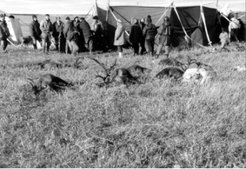Property and Economy among reindeer herders and hunters in a Dolgan village, North-western Republic of Sakha, Siberia.
Property and Economy among reindeer herders and hunters in a Dolgan village, North-western Republic of Sakha, Siberia.

The situation, where different forms of property and informal and formal structures intertwine, makes Urung Khaia an interesting place. Although some researchers argue that the most popular and widespread form of aboriginal reorganisation in Siberia is the clan-based community (obshchina) (Sirina 1999; Fondahl 2000), this is not the case in Anabarski district. The first new enterprises, registered there between 1992 and 1994, were peasant farms (khrestianskoie khoziaistvo). Many of these enterprises were turned to clan-based communities and later into family enterprises (semeinoie khoziaistvo). Using new laws, people created and reregistered their enterprises constantly. Because Anabarski district is dominated by natives who run the administration and the main enterprises, there is neither a polarisation between incomers and natives, nor an oppression of the natives, which gives to the creation of native enterprises a certain ideological "back to the roots" character that can be observed in other Siberian regions. In Anabarski district, the reindeer herders and hunters use the laws and different statuses of the enterprises to get better access to state subsidies. Although the land use rights are fixed, privatisation of the land is not taking place. Partly it is due to the lack of an ethnic polarisation, which is one of the reasons for land privatisation in Taimyr (Ziker 2001). Partly because in Anabarski district there are no conflicts with the industry, a reason that encourages reindeer herders to register their territories to keep the industry away (cf. Stammler). The users of certain territories and their rights to these lands are known, even if they are informal, they are recognized. "Knowing the lands", knowledge gained over a long period using of time using certain regions, gives a person the right to consider this region as his own. This is usual practice among Siberian hunters and reindeer herders (Anderson 2000).
Besides by Dolgans Anabarski district is populated by Evenki and Even as well. Although Soviet ethnographers tried to defy the ethnic identity of the population of the Anabarski district as only Sakha, Evenki, etc.,(Dolgikh 1952; Suslov 1952; Gurvich 1977), in fact formal ethnic affiliation on paper is not so important in this region. The institutionalised ethnicity did not cause conflicts among native groups as was the case in the neighbouring Krasnoiarski Krai (Anderson 2000), but it is largely ignored. The kinships are not ethnicity based and unite people with different ethnic affiliation. It is through these relations that access to the resources is determined. Kinship networks cover the whole economic landscape and offer people more security than official structures. Due to this fact the formal status of the enterprises is not very important to their cooperation.
References
Anderson, D. G. (2000). Identity and ecology in Arctic Siberia: the number one reindeer brigade. Oxford, Oxford University Press.
Dolgikh, B. O. (1952). "O naselenii basseiniv rek Oleneka i Anabara." Sovetskaia etnofrafiia no.2: 86-91.
Fondahl, G., Lazebnik, Olga, Poelzer, Greg (2000). "Aboriginal Territorial Rights and the Sovereignty of the Sakha Republic." Post-Soviet Geography and Economics, 41(No.6): 401-417.
Gurvich, I. S. (1977). Kul'tura senernykh yakutrov-olenovodov. Moscow, Nauka.
Sirina, A. (1999). . Rodovye obschiny malochislennykh narodov Severa v Respublike Sakha (Yakutia): shag k samoopredeleniiu?, Issledovaniia po prikladnoi i neotlozhnoi etnologii. Moscow, Institut Etnologii i Antropologii.
Suslov, M. M. (1952). "O natsional'noi prinadlezhnosti sovremennogo naseleniia Severo-Zapada Yakutskoi ASSR." Sovetskaia etnografiia no.2: 69-72.
Ziker, J. (2001). "Land Use and Social Change among the Dolgan and Nganasan of Northern Siberia." Senri Ethnological Studies 59: 47-65.
